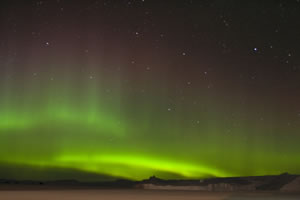Although the atmosphere may seem uniform when we look up at the sky, it changes dramatically from the lowest level near the ground to the highest region near outer space.
The troposphere is the atmosphere's lowest layer. It contains about 4/5 of the atmosphere's total mass. It varies in size, reaching all the way to about 11 miles (18 kilometers) above ground level at the equator. At the poles, the troposphere extends to only about 5 miles (8 kilometers).
Most of the water vapor in the Earth's atmosphere is in the troposphere, and the troposphere is where weather happens.
In the troposphere, as altitude increases, the density of the air decreases and temperature decreases. At high altitudes, people can become deprived of oxygen because the lower air pressure makes it harder for oxygen to get pass through the lung membranes. Some people whose ancestors have lived in very high mountains, such as the Himalayas and the Andes, for a long time have developed physical adaptations to their respiratory and circulatory systems to account for the lower oxygen pressure.
The upper boundary of the troposphere is known as the tropopause. The temperature here is about -71 degrees Fahrenheit (-57 degrees Celsius).
Above it is the stratosphere, which reaches up to about 31 miles (50 kilometers) above the surface of the Earth. The troposphere contains the ozone layer. The ozone layer absorbs ultraviolet radiation and produces heat. Because of this, in the troposphere, temperature increases as altitude increases. At the stratopause, the upper boundary of the stratosphere, the temperature is around 14 degrees Fahrenheit (-10 degrees Celsius).
The jet streams, strong winds that rotate around the Earth, are located in the upper part of the troposphere and the lower section of the stratosphere. The jet streams move from west to east and are much more regular than winds closer to the Earth's surface. When planning flights by air, the movement of jet streams is always taken into account, as flight times can be greatly decreased or increased, depending on whether the aircraft flies with or against a jet stream.
Jet streams have a strong influence on weather near the ground in temperate zones.

Above the stratosphere is the ionosphere, which extends from about 30 to 300 miles (50 to 500 kilometers) above the Earth's surface. The ionosphere is constantly blasted with ultraviolet radiation, solar X-rays and cosmic rays. All of this radiation changes the molecules of gas in the ionosphere into electrically charged particles. These particles are known as ions. When streams of charged particles from the sun ionize gases in the ionosphere, striking, colorful displays known as The Aurora Borealis and the Aurora Australis are created. Also known as the Northern and Southern lights, the Auroras are usually seen only near the poles.
The lower region of the ionosphere, which extends to about 56 miles (90 kilometers) above the Earth's surface, is known as the mesosphere. The upper part of the ionosphere is the thermosphere.
In the mesosphere, gases become thinner and temperatures decrease with altitude.
Gases are even thinner in the thermosphere, and get less dense as height increases. However, temperature increases with height because a layer of molecules in the thermosphere absorbs solar ultraviolet and X-rays, generating heat. Temperatures at the top of the thermosphere can reach 3,600 degrees Fahrenheit (2,000 degrees Celsius).
Above the ionosphere is the exosphere. It reaches up to 6,2000 miles (10,000 kilometers) above the Earth. This is the highest part of the Earth's atmosphere, and the boundary between Earth and outer space. The exosphere is very thin and contains atoms of hydrogen, helium and oxygen.